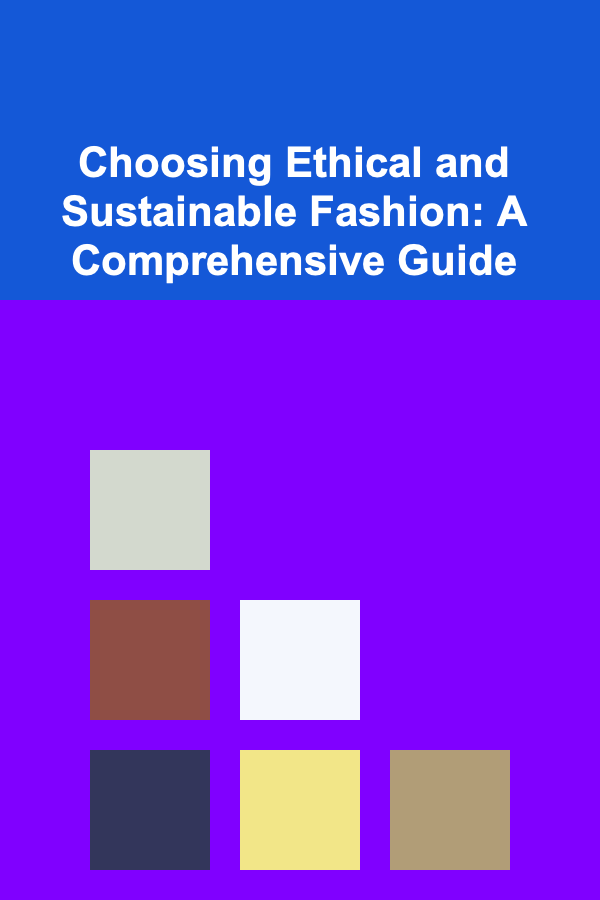
Choosing Ethical and Sustainable Fashion: A Comprehensive Guide
ebook include PDF & Audio bundle (Micro Guide)
$12.99$8.99
Limited Time Offer! Order within the next:

The fashion industry, a global behemoth responsible for trillions of dollars in revenue annually, is also a significant contributor to environmental degradation and social injustice. From the cotton fields sprayed with harmful pesticides to the sweatshops where garments are assembled under exploitative conditions, the industry's practices often come at a steep cost. Choosing ethical and sustainable fashion, therefore, isn't merely a trend; it's a conscious decision to support practices that prioritize people and the planet over profit. This guide provides a comprehensive overview of how to navigate the complex landscape of ethical and sustainable fashion, empowering you to make informed choices and contribute to a more responsible industry.
Understanding the Issues: Why Ethical and Sustainable Fashion Matters
Before diving into solutions, it's crucial to understand the multifaceted problems within the conventional fashion industry. These challenges can be broadly categorized into environmental and social concerns.
Environmental Impacts
The environmental footprint of fashion is staggering. Consider these factors:
-
Water Consumption: The production of cotton, a widely used fabric, is incredibly water-intensive. It takes thousands of liters of water to produce just one kilogram of cotton. This puts immense pressure on water resources, especially in regions already facing water scarcity. Furthermore, dyeing and finishing processes require vast amounts of water, often discharged as polluted wastewater containing toxic chemicals.
-
Pollution: The fashion industry is a major source of pollution, impacting air, water, and soil. Pesticides used in cotton farming contaminate water sources and harm ecosystems. Chemicals used in dyeing and finishing processes, such as formaldehyde and heavy metals, can be released into waterways, harming aquatic life and potentially entering the human food chain. Furthermore, the production of synthetic fibers like polyester relies on fossil fuels, contributing to greenhouse gas emissions.
-
Textile Waste: The "fast fashion" model, characterized by rapid production cycles and low prices, encourages overconsumption and generates massive amounts of textile waste. Millions of tons of clothing end up in landfills each year, where they decompose and release harmful greenhouse gases like methane. Even incineration, another common disposal method, contributes to air pollution.
-
Deforestation: The demand for fabrics like viscose and rayon, often marketed as "natural" alternatives to cotton, can contribute to deforestation. These fabrics are made from wood pulp, and the unsustainable harvesting of trees can lead to habitat loss and biodiversity decline.
-
Microplastics: The washing of synthetic fabrics releases microscopic plastic particles called microplastics into waterways. These microplastics are ingested by marine life and can potentially enter the human food chain, posing a threat to human health.
Social Impacts
Beyond the environmental concerns, the fashion industry is plagued by significant social issues:
-
Labor Exploitation: Many garment workers, particularly in developing countries, face exploitative working conditions. They often work long hours for extremely low wages, with little or no job security or benefits. Child labor and forced labor are also prevalent in some parts of the industry.
-
Unsafe Working Conditions: Garment factories are often unsafe, with inadequate ventilation, fire hazards, and exposure to hazardous chemicals. Tragic incidents like the Rana Plaza collapse in Bangladesh highlight the devastating consequences of prioritizing profits over worker safety.
-
Lack of Transparency: Many fashion brands lack transparency in their supply chains, making it difficult to trace the origin of their products and ensure that they are produced ethically. This lack of transparency allows exploitative practices to persist unchecked.
-
Impact on Artisans: The rise of fast fashion has undermined traditional crafts and marginalized artisans in many communities. Mass-produced clothing often undercuts the prices of handcrafted items, making it difficult for artisans to earn a living and preserve their cultural heritage.
Key Principles of Ethical and Sustainable Fashion
Ethical and sustainable fashion encompasses a range of practices that aim to minimize the negative environmental and social impacts of the industry. Here are some key principles to guide your choices:
-
Environmental Sustainability: Prioritizing materials and production processes that minimize environmental harm. This includes using organic cotton, recycled materials, and low-impact dyes; reducing water and energy consumption; minimizing waste; and promoting circular economy principles.
-
Fair Labor Practices: Ensuring that garment workers are treated with dignity and respect, receive fair wages, work in safe conditions, and have the right to organize and bargain collectively.
-
Transparency and Traceability: Promoting transparency throughout the supply chain, allowing consumers to trace the origin of their clothing and verify that it is produced ethically and sustainably.
-
Animal Welfare: Avoiding the use of animal products, such as fur, leather, and angora wool, or ensuring that animals are treated humanely in the production of these materials.
-
Reducing Consumption: Shifting away from a culture of overconsumption and embracing a more mindful approach to fashion. This includes buying fewer, higher-quality items; caring for clothing properly to extend its lifespan; and exploring alternatives to buying new clothes, such as renting, borrowing, and buying secondhand.
Practical Steps to Choosing Ethical and Sustainable Fashion
Now that we've established the underlying principles, let's explore practical steps you can take to make more ethical and sustainable fashion choices:
1. Research and Educate Yourself
The first step is to become informed about the issues and the brands that are committed to ethical and sustainable practices. Utilize online resources, read articles and reports, and follow organizations that are working to promote responsible fashion. Look for information about:
-
Brand Transparency: Does the brand openly disclose information about its supply chain, including the location of its factories and the wages paid to workers? Do they publish impact reports that detail their environmental and social performance?
-
Certifications: Does the brand have certifications from reputable organizations that verify their ethical and sustainable practices? Examples include Fair Trade, GOTS (Global Organic Textile Standard), Oeko-Tex, and B Corp.
-
Materials Used: What types of materials does the brand use? Are they organic, recycled, or sustainably sourced? Are they phasing out the use of harmful chemicals?
-
Labor Practices: What measures does the brand take to ensure fair labor practices in its supply chain? Do they conduct regular audits of their factories? Do they provide workers with training and empowerment programs?
2. Support Ethical and Sustainable Brands
Once you've done your research, start supporting brands that are committed to ethical and sustainable practices. Here are some things to look for:
-
Brands with Clear Ethical Policies: Look for brands that have clear and comprehensive ethical policies that address issues such as fair labor practices, environmental sustainability, and animal welfare. These policies should be publicly available and easily accessible on the brand's website.
-
Brands Using Sustainable Materials: Choose brands that prioritize the use of sustainable materials, such as organic cotton, recycled polyester, hemp, linen, and Tencel (lyocell). These materials have a lower environmental impact than conventional materials.
-
Brands Focused on Durability and Longevity: Support brands that design clothing that is made to last. Look for durable fabrics, well-constructed garments, and timeless designs that won't go out of style quickly. Investing in quality pieces that you can wear for years to come is more sustainable than buying cheap, disposable clothing.
-
Consider B Corp Certified Companies: B Corp certification signifies that a company meets high standards of social and environmental performance, accountability, and transparency. Supporting B Corp certified fashion brands ensures that you are supporting businesses that are committed to using business as a force for good.
-
Look for Fair Trade Certification: Fair Trade certification ensures that producers and workers receive fair prices and wages, work in safe conditions, and have access to healthcare and education. Supporting Fair Trade fashion brands helps to empower marginalized communities and promote economic justice.
3. Embrace Secondhand and Vintage Shopping
Buying secondhand or vintage clothing is one of the most sustainable ways to shop. It extends the lifespan of existing garments, reduces the demand for new production, and keeps clothing out of landfills. Explore:
-
Thrift Stores: Local thrift stores often have a wide selection of clothing at affordable prices. You can find unique and vintage pieces that you won't find anywhere else.
-
Consignment Shops: Consignment shops sell gently used clothing and accessories on behalf of individual owners. They often have a curated selection of higher-end brands and designer items.
-
Online Marketplaces: Online marketplaces like eBay, Poshmark, and ThredUp offer a vast selection of secondhand clothing. You can filter your search by size, brand, style, and price.
-
Vintage Stores: Vintage stores specialize in clothing from past eras. They often have unique and stylish pieces that are perfect for adding a touch of individuality to your wardrobe.
-
Clothing Swaps: Organize or participate in clothing swaps with friends, family, or community groups. This is a fun and sustainable way to refresh your wardrobe without buying anything new.
4. Rent or Borrow Clothing
For special occasions or events, consider renting or borrowing clothing instead of buying something new. Clothing rental services offer a wide selection of designer dresses, suits, and accessories for a fraction of the retail price. This is a more sustainable and cost-effective option than buying a new outfit that you might only wear once.
5. Care for Your Clothes Properly
Properly caring for your clothes can significantly extend their lifespan. Follow these tips:
-
Wash Clothes Less Frequently: Overwashing can damage fabrics and fade colors. Only wash clothes when they are visibly dirty or smelly.
-
Wash Clothes in Cold Water: Washing clothes in cold water saves energy and reduces the risk of fading and shrinking.
-
Use a Gentle Detergent: Harsh detergents can damage fabrics and release harmful chemicals into the environment. Choose a gentle, eco-friendly detergent.
-
Air Dry Your Clothes: Air drying clothes saves energy and prevents shrinkage and damage from the dryer.
-
Repair Clothes Instead of Replacing Them: Learn basic sewing skills so you can repair minor damages like tears, buttons, and hems. Extending the life of your clothes is a key aspect of sustainable fashion.
6. Reduce Consumption and Embrace Minimalism
The most sustainable fashion choice is often to buy less. Embrace a minimalist approach to fashion by focusing on building a capsule wardrobe of versatile, high-quality pieces that you can mix and match. Before buying anything new, ask yourself:
-
Do I really need this item?
-
Do I already have something similar?
-
How often will I wear it?
-
Is it made from sustainable materials?
-
Will it last a long time?
7. Dispose of Clothing Responsibly
When you no longer want or need clothing, dispose of it responsibly. Don't just throw it in the trash. Consider these options:
-
Donate to Charity: Donate gently used clothing to local charities or organizations that support people in need.
-
Recycle Textiles: Many communities have textile recycling programs that collect unwanted clothing and fabric scraps for reuse or recycling. Check with your local recycling center to see if they accept textiles.
-
Upcycle or Repurpose Clothing: Get creative and upcycle or repurpose old clothing into new items. You can turn old t-shirts into shopping bags, old jeans into quilts, or old sweaters into blankets.
8. Advocate for Change
Support policies and initiatives that promote ethical and sustainable fashion. Contact your elected officials and urge them to support legislation that addresses issues such as fair labor practices, environmental protection, and supply chain transparency. Support organizations that are working to hold fashion brands accountable for their social and environmental impacts.
Navigating Greenwashing: Identifying Authentic Sustainability
Greenwashing, the practice of misleading consumers about the environmental benefits of a product or service, is rampant in the fashion industry. It's crucial to be able to discern genuine sustainability efforts from marketing ploys. Here's how to spot greenwashing:
-
Vague or Unsubstantiated Claims: Beware of claims that are vague, generic, or lack specific evidence. Terms like "eco-friendly," "natural," and "sustainable" can be meaningless if they are not backed up by concrete data or certifications.
-
Focus on a Single Attribute: Some brands focus on a single sustainable attribute while ignoring other significant environmental or social impacts. For example, a brand might highlight the use of organic cotton while still relying on exploitative labor practices.
-
Hidden Trade-offs: Some "sustainable" products may have hidden trade-offs. For example, a garment made from recycled plastic bottles might still contribute to microplastic pollution.
-
Lack of Transparency: Brands that are truly committed to sustainability are transparent about their supply chains and manufacturing processes. If a brand is unwilling to provide information about its sourcing and production practices, it's a red flag.
-
False Labels: Some brands create their own "eco-labels" that have no real meaning or certification. Stick to reputable third-party certifications like Fair Trade, GOTS, and Oeko-Tex.
To avoid being misled by greenwashing, always do your research, look for credible certifications, and ask brands for more information about their sustainability practices.
The Role of Consumers in Driving Change
Ultimately, the power to transform the fashion industry lies with consumers. By making conscious choices, we can send a strong message to brands that we demand ethical and sustainable practices. Here's how:
-
Demand Transparency: Ask brands questions about their supply chains, labor practices, and environmental impacts. Hold them accountable for their actions.
-
Support Ethical and Sustainable Brands: Vote with your wallet by supporting brands that are committed to ethical and sustainable practices.
-
Spread Awareness: Talk to your friends and family about ethical and sustainable fashion. Share information on social media and encourage others to make conscious choices.
-
Participate in Advocacy Efforts: Join organizations that are working to promote responsible fashion. Support policies that hold brands accountable for their social and environmental impacts.
By working together, we can create a more just and sustainable fashion industry that benefits both people and the planet.
Conclusion: A Journey Towards Conscious Consumption
Choosing ethical and sustainable fashion is not a one-time decision but an ongoing journey. It requires a shift in mindset, a willingness to challenge conventional norms, and a commitment to making informed choices. While the path may seem complex and challenging, the rewards are immense. By embracing ethical and sustainable fashion, we can reduce our environmental impact, support fair labor practices, and contribute to a more just and equitable world. Let us all strive to be more conscious consumers and use our purchasing power to create a fashion industry that is both stylish and sustainable.
Reading More From Our Other Websites
- [Home Cleaning 101] How to Clean a Microwave: Effortlessly Remove Stains and Smells
- [Home Party Planning 101] How to Throw a Harry Potter-Themed Birthday Party for Adults
- [Home Staging 101] How to Stage a Home with a Small Budget and Limited Time
- [Personal Care Tips 101] How to Find the Right Supplements for Your Needs
- [Home Soundproofing 101] How to Use DIY Methods for Soundproofing Your Home Effectively
- [Sewing Tip 101] Sewing Class Success Stories: How Learning to Stitch Transformed These Creators
- [Scrapbooking Tip 101] Seasonal Stories: Scrapbooking Themes for Every Time of Year
- [Home Budget Decorating 101] How to Unlock Genius Cheap Ideas for a Small Space to Make It Feel Grand and Organized
- [Personal Finance Management 101] How to Start Investing with Little Money
- [Home Renovating 101] How to Modernize Your Kitchen with the Perfect Hardware: A Style Guide to Kitchen Hardware Trends

How to Master DIY Home Cleaning Products
Read More
How to Protect Your Home's Wi-Fi Network from Hackers
Read More
The Ultimate Renting vs. Buying Comparison: Pros and Cons You Need to Know
Read More
Unearthing Terroir: Identifying the Specificity of Single Vineyard Wines
Read More
Understanding the Genetics of Nutrition: Nutrigenomics and Beyond
Read More
10 Tips for Maintaining and Caring for Your Stationery Set
Read MoreOther Products

How to Master DIY Home Cleaning Products
Read More
How to Protect Your Home's Wi-Fi Network from Hackers
Read More
The Ultimate Renting vs. Buying Comparison: Pros and Cons You Need to Know
Read More
Unearthing Terroir: Identifying the Specificity of Single Vineyard Wines
Read More
Understanding the Genetics of Nutrition: Nutrigenomics and Beyond
Read More